Core Than Meets the Eye
Last week, I began Core Set 2020 previews. While I talked about a number of key features of the set, there's still more to discuss. And I'm going to do so by talking about all the cycles in the set, one of which is my preview cards for today (yes, five preview cards). Do note that some of the cards in these cycles haven't been previewed yet, so there are a few gaps here and there.
Now sit back and buckle in as I take you through a tour of the many cycles of Core Set 2020.
Common Cycles
Ten-Card Cycle of Life-Gain Tap Lands
One of the goals of the core set is to make sure that many of the needed basic tools are available for Standard. This includes some common dual lands that can help players build multicolor decks if they don't have access to the higher-rarity duals lands. For Core Set 2020, the Set Design team chose to include the life-gain tap lands from Khans of Tarkir. These are dual lands that enter the battlefield tapped and give you 1 life when they enter the battlefield.
The allied versions of these lands first appeared in original Zendikar. We'd already done the plain tap lands before (aka dual lands that entered the battlefield tapped with no other abilities), and we realized we had a little room to make them more powerful. Gaining 1 life felt like a generally useful and simple ability to give them. Khans of Tarkir renamed the allied lands (as the original lands had specific Zendikar words in their titles) and added enemy lands to fill out a full ten-card cycle.
"Care About" Spells
This cycle includes my preview cards for today, so let me show them off first and then I'll talk about them.
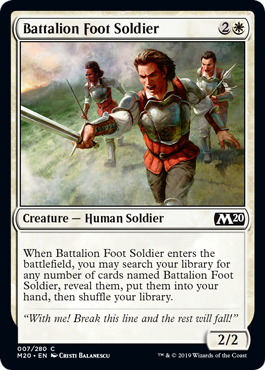
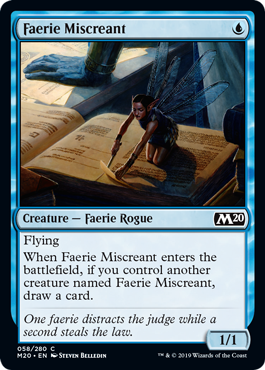

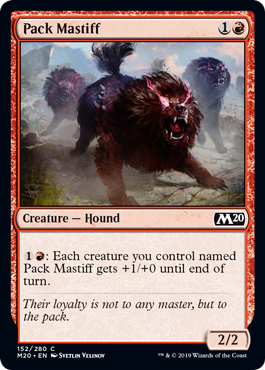

This cycle is five cards that all care about having more copies of the same card. Each one cares about it in a different way, but all of them encourage you to either play four in a Constructed format or draft as many of you can in Draft. They're at common to make it easy to do so. These cards play into a theme that goes all the way back to Limited Edition (Alpha).
Remember that when the game first started there weren't any card limits, so Richard Garfield was interested in designing a card that encouraged you to play with as many copies of it as you'd managed to collect. (And yes, I do believe Plague Rats would have had the "a deck can have any number of cards named _____" text if four-card limits were a thing at the game's start.) Richard had planned for the game to be a normal game and not the runaway success it became, so the idea of having a deck full of Plague Rats was meant to be a true trading challenge.
Plague Rats was a very popular card and, over the years, has inspired numerous designs that play in a similar space (for example, Slivers are a direct offshoot of Plague Rat). One of the cards I designed inspired by Plague Rats was called Kindle in Tempest, and it explored pushing the Plague Rats idea beyond just the scope of caring about what other cards were on the battlefield. Kindle, in turn, has influenced many other designs, including some of today's preview cards.
The idea behind this cycle was giving new players a clean, simple task to pursue. In Constructed, the cards tell you to put four into your deck. In Draft, they create a clear Draft strategy—draft as many copies of one of these cards as you can. I hope you all manage to have some fun with this cycle yourselves.
Uncommon Cycles
Creatures with Protection
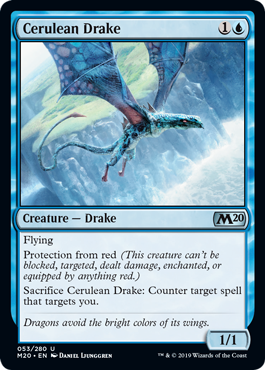
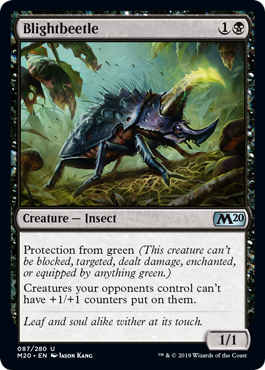
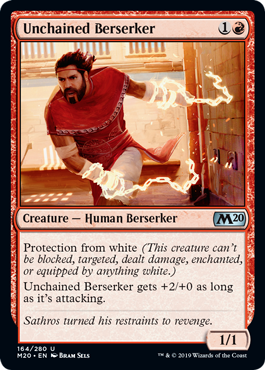

Protection from _____ is an ability that goes all the way back to the game's beginning. For most of Magic's life, it's been an evergreen mechanic, meaning it appeared in (almost) every set. In Magic Origins, we moved it from being an evergreen mechanic to being deciduous, meaning that it could appear when we needed it, but less often than an evergreen mechanic.
Many members of R&D felt we've dipped a little too low in our usage of protection and were interested in having it appear at a higher frequency than it has these last few years. Play Design, in particular, was interested in having more protection as it's a very efficient tool to help balance the metagame. The Core Set 2020 Set Design team experimented with creating a similar mechanic to protection with a little less rules complication (they even explored using the word "protection" but simplifying how the mechanic worked) but, in the end, decided to just go with protection as is.
In this set, protection shows up on just six cards, five of which are a creature cycle (the other is an uncommon white instant). Technically, it's not an uncommon cycle as only four of the cards are uncommon and one card (the green one) is rare. My best guess is that they all started out as uncommon cards, and the protection got shifted from a green uncommon creature to a green rare creature for Play Design reasons. Each of these creatures has protection from one of its enemy's colors and that cycle goes around the color wheel so each color has one creature with protection from it.
I'm not quite sure about the future of protection, but it seems to be on one of two paths—either a return to evergreen status or a staying deciduous but with a heavier use in Standard-legal sets.
Color-Hosing Spells
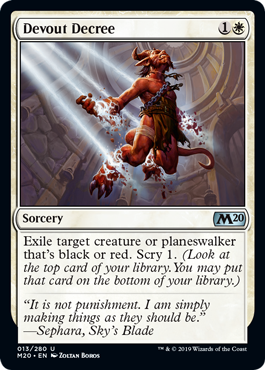
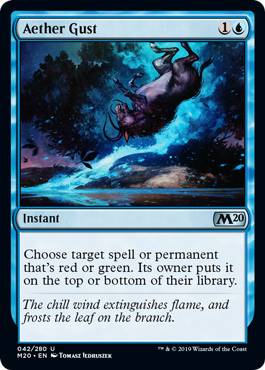
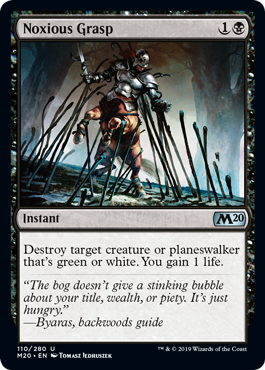
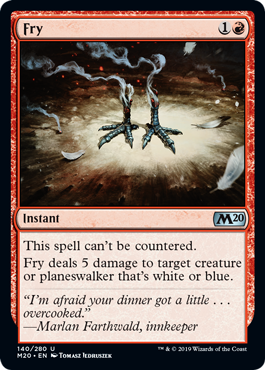
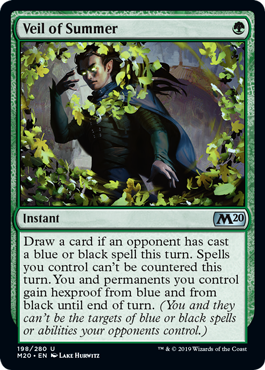
This is a cycle of instants and sorceries that all work against the two colors that are enemies to that color. ("Color hosing" is slang for spells that specifically hurt one or more colors.) Note that these cards only work on the enemy colors, meaning they're designed to be used most often as sideboard cards. Core sets like to have "color hosers" as they do a good job of explaining the relationship between the colors. It's easy to forget that the idea that colors are friendly to the ones next to them on the color wheel and the enemies of those are across from them is something that's not inherently obvious to new players. Magic was louder about it in its early years, but we've scaled a bit back on it for gameplay reasons. Color hosers also act as a means to start teaching players about what they can do to adapt to their friend's deck. If you keep losing to a red deck, for example, perhaps you want to include some cards that are particularly good against red things. Note that protection serves a similar role.
Gold Draft Archetypes
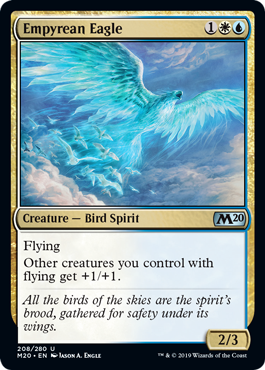


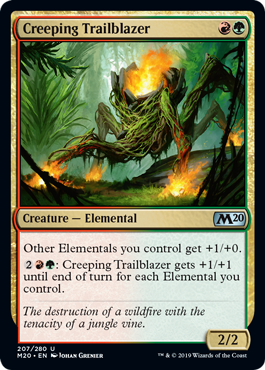
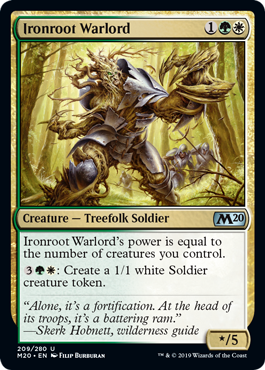
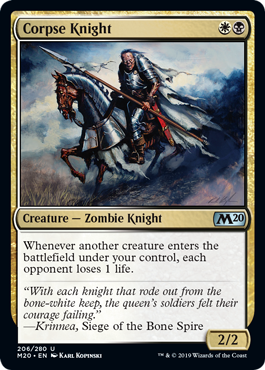
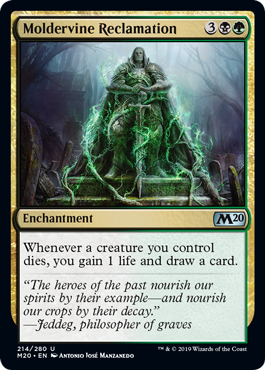
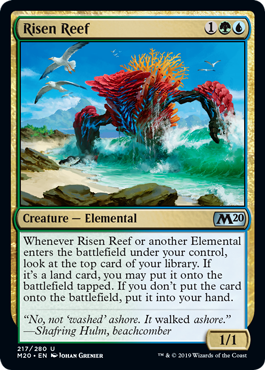
One of the innovations that Erik Lauer introduced to design when he first started in R&D was gold uncommon Draft archetype cards. These are uncommon multicolor cards (most often two-color) that loudly communicate what those colors are doing in the draft. The idea is that if you draft these cards early, that they'll send you down a path that will be reinforced by the other cards in the set. For example, as I explained last week, in Core Set 2020, white and blue are about flying. By giving you a white or blue card that specifically references flying, we help communicate the theme of white and blue. Core Set 2020 has Draft archetypes for each of the two-color pairs, and these ten cards serve as guideposts to help drafters. (For more information on what exactly those Draft themes are, check out my column from last week).
Colored Artifacts
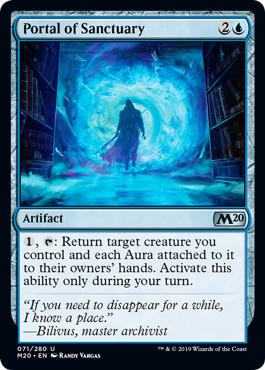
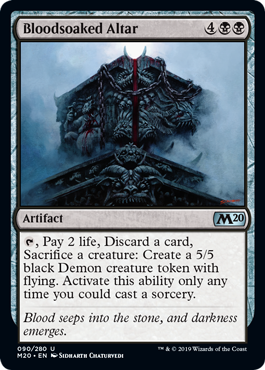
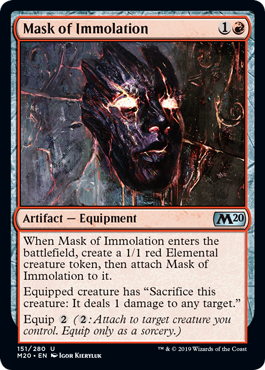
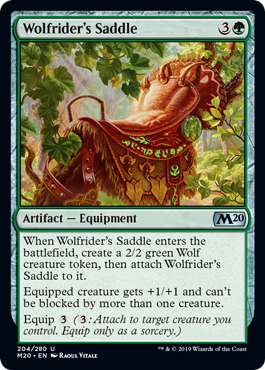
One of the results of Kaladesh's harsh impact on Standard was R&D taking a long look at artifacts. Historically, almost every set with a focus on playing a lot of artifacts has resulted in Play Design issues, often leading to bannings. We know from our market research that players are very fond of artifacts, so we wanted to find a way to keep doing them but knew we needed a way to address the problems they keep creating. The obvious answer after studying the problem was that we needed to start incorporating the color wheel. The fact that a broken artifact could go in almost any deck made mistakes on an artifact much more problematic than a normal overpowered card.
By starting to make more colored artifacts, we could allow the color wheel to do its job and start limiting what decks could play a particular card. Artifacts have often been flavored leaning toward a certain color, so the flavor aspect seemed fine. The big issue was artifacts stepping on the toes of enchantments, but we decided it was necessary for the good of the game, so we've chosen to lean more on the creative to separate the two and less on mechanical differences (although, there are still a few, like enchantments not tapping). Note we will still be making some generic mana artifacts, we're just going to be willing to push more on the colored ones. This means that the generic cost artifacts will be more for Limited, casual Constructed play, or niche-y cards for Constructed (that is, cards that can't just be put into any deck).
Because of this decision, we've made colored artifacts a deciduous thing (with the possibility of just becoming evergreen). We felt a core set was a good place to include them as we want to start introducing new players to the idea that these are just something Magic does. To do that, the Core Set 2020 Set Design team made a cycle of uncommons (three Equipment and two non-Equipment). There's also one rare colored artifact, Chandra's Regulator, which I previewed last week.
Rare Cycles
Enemy Scry Lands (Temples)
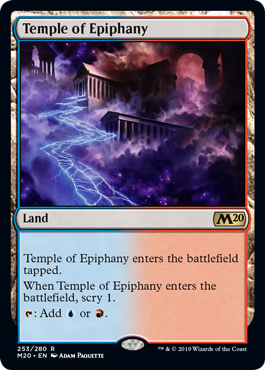

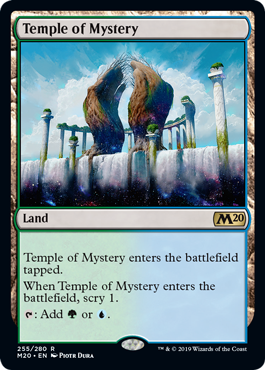
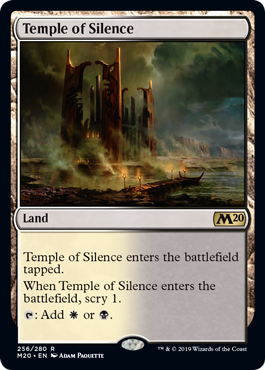

The scry lands (or Temples) first appeared in Theros block, doled out over the three sets. They are dual lands that come into play tapped, but instead of giving you 1 life, they allow you to scry for 1. When these lands first appeared, players were a bit lukewarm to them, but they quickly proved themselves in tournament play.
Why are these the rare dual lands in Core Set 2020? Dual lands are not dictated by the Vision Design or Set Design teams, but rather Play Design. (The one exception is when the mechanics of a set strongly push toward a compelling dual land mechanic.) Play Design looks at the Standard environment as a whole and recommends a mix of dual lands that will create a good mix for tournament play. It was time for an enemy color dual cycle, so Core Set 2020 gets the enemy scry lands. I believe the scry lands were chosen because they played well with the larger Standard metagame.
Leylines
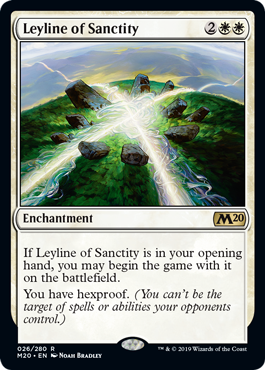
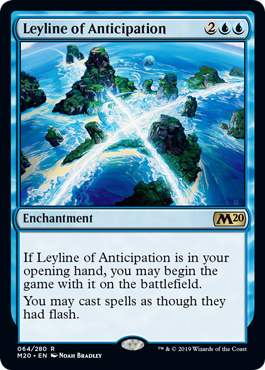
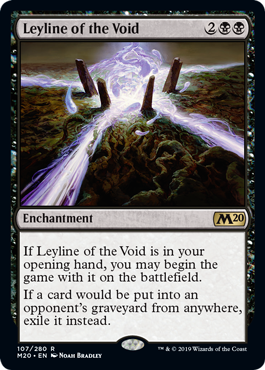
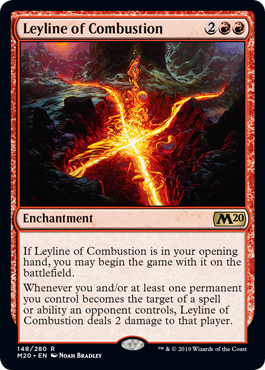
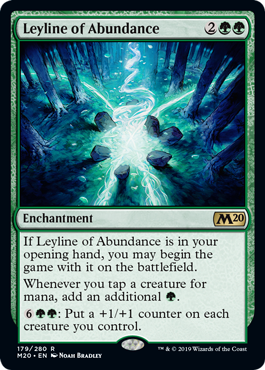
Leylines are enchantments that begin the game on the battlefield if they're in your opening hand. They tend to be protective global effects. They first appeared in Guildpact (and then later in Magic 2011) and were designed as a means to give you an answer to early threats and thus are often used in sideboards or to adjust to extreme metagame issues. Leylines have returned in Core Set 2020 with three reprints and two new ones.
For those asking why some of them are old and some of them are new, the answer is that Leyline designs are difficult to do. They have a very narrow design space to fill, so when we find good Leyline designs, we tend to reuse them.
Monocolor Legendary Iconic Creatures
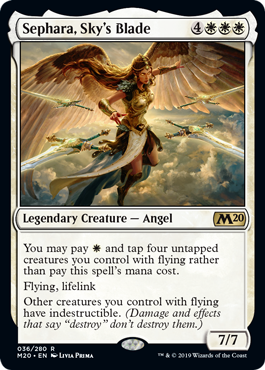
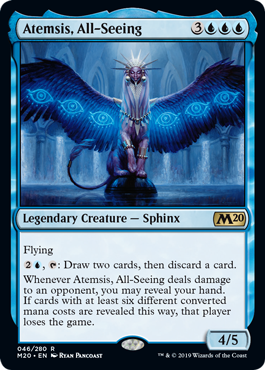
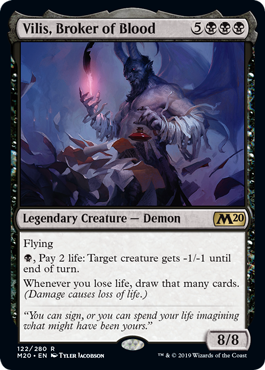

Another thing the core set likes to introduce is our iconic creatures. For each color, we have a popular creature type that we tend to focus in rare and mythic rare that plays up the color's key attributes. White's iconic is Angel, blue's is Sphinx, black's is Demon, red's is Dragon, and green's is Hydra. Core Set 2020 made a rare cycle of legendary creatures of the five iconics. Each one is designed to be splashy and thematic to its color. We want to let newer players (and more established ones) have access to exciting iconic creatures right out of the gate. They were made legendary, both to allow them to be commanders and to give them a little extra oomph. Our market research shows that being a character tends to make cards more attractive to the majority of players.
"Double" Cards
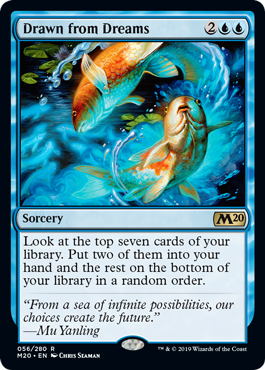

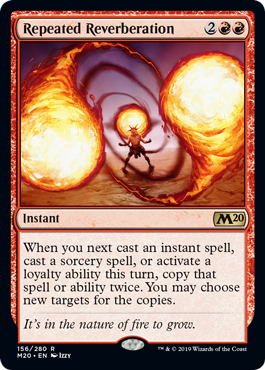
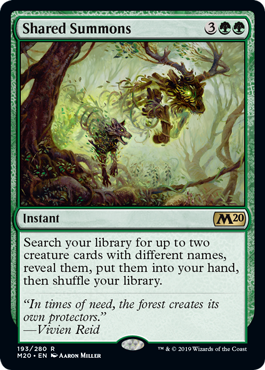
I wasn't sure whether to include this cycle, as it's what we call a "soft" cycle in that it's pretty subtle and doesn't draw attention to itself, but I listed every other cycle in the set, so I felt I was obligated to point this one out as well. This cycle includes all instants and sorceries that have an effect that happens twice. In design, they all had "double" in their name (but we'd already done that gimmick in Unglued). In the finished product, they all have alliterative names and a card concept that involves two of something.
Mythic Rare Cycles
Cavaliers
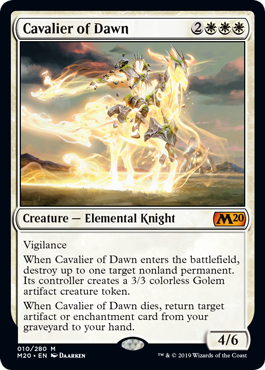
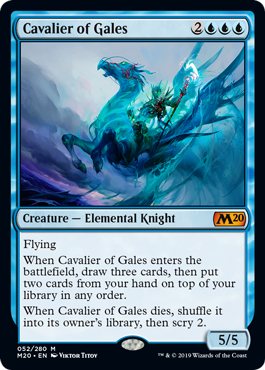
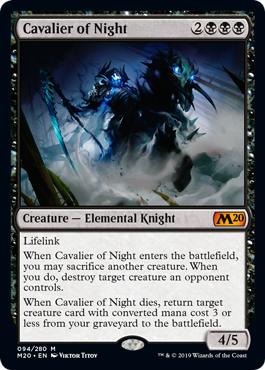
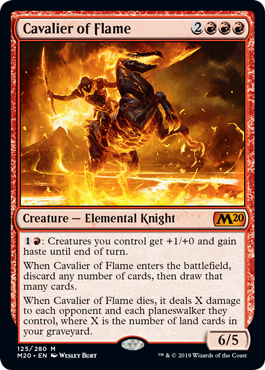

This a creature cycle of Elemental Knights that all cost 2MMM (where M stands for the colored mana of the card it's on). Each of these creatures has an evergreen creature keyword, an "enters-the-battlefield" effect, and a death effect, meaning the creature does one thing when it enters and another when it goes to the graveyard. The red card, Cavalier of Flame, was one of my preview cards from last week. This cycle plays into the "Elementals matter" theme I talked about in part one. Being Knights, they also play with the little bit of Knight tribal in Dominaria.
Monocolored Planeswalkers
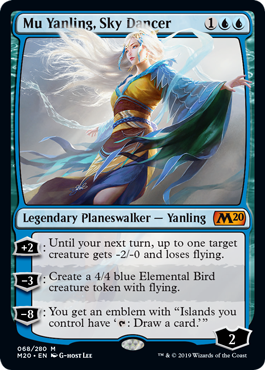
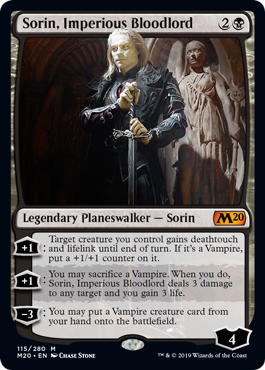
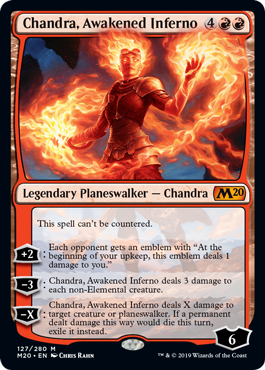
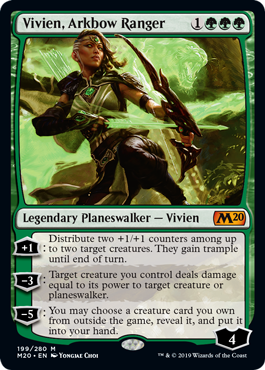
Another staple of core sets (well, since Lorwyn) has been a cycle of monocolored planeswalkers. For a long time, we tended to print the same ones in core sets, but we've started mixing them up a little more, not just using different characters, but making new planeswalker card designs. Chandra had to be the red one as she's the face of the set (and, as I showed you last week, has three different planeswalker cards, one in each rarity other than common). Mu Yanling was chosen for blue because she fit the elemental theme of the set (she has elemental powers controlling air and water). We decided to give Liliana a rest after the events of War of the Spark, so Sorin took the mantle of the black planeswalker. (While Sorin is white-black, he definitely leans more toward his black side.) For green, we had a choice between Nissa and Vivien, going with Vivien as she's had a little less time in the spotlight.
Wedge Legends
As I explained last week, after Core Set 2019 went with the Elder Dragons which were legendary arcs (or shards—aka a color and its two allies), Core Set 2020 decided instead to make a cycle of legendary wedge creatures (wedge being a color and its two enemies). This cycle of creatures was designed very much with Commander and Brawl in mind. You can tell that Core Set 2019 and Core Set 2020 are definitely setting a new trend of a higher amount of multicolor in core sets as well as having more legendary creatures.
Core to Come
That's all the cycles in Core Set 2020. Hopefully, between this week and last week, you have a good sense of what's in the set. As always, I'm interested in your feedback, both on today's column and on anything about Core Set 2020. You can email me or contact me through any of my social media accounts (Twitter, Tumblr, and Instagram).
Join me next week when I start sharing some card-by-card stories about Core Set 2020.
Until then, may you have fun playing with the cycle (or parts of a cycle) that excite you the most.
#647: Designing Library Effects
#647: Designing Library Effects
39:59
This episode is another in my "Designing _____" series where I talk about how we design certain basic effects. In this episode, I talk about effects interacting with the library.
#648: Working on the Road
#648: Working on the Road
38:55
Part of my job is traveling. This podcast talks about what it's like working when traveling as well as the many things that have to be done before or after you've traveled.
- Episode 646 Seeing the World
- Episode 645 Languages
- Episode 644 Ajani's Pridemate

